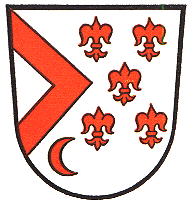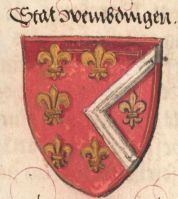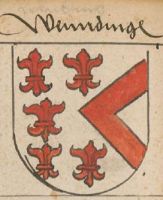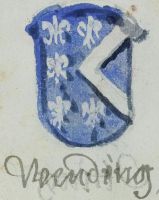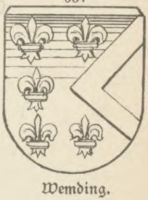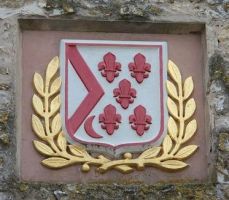Wemding: Difference between revisions
Knorrepoes (talk | contribs) m (Text replacement - "{{de}}" to "") |
Knorrepoes (talk | contribs) m (Text replacement - "|'''English''' ↵| {{blazon wanted}}" to "|'''English''' | blazon wanted") |
||
| Line 16: | Line 16: | ||
|- | |- | ||
|'''English''' | |'''English''' | ||
| | | blazon wanted | ||
|} | |} | ||
Revision as of 10:33, 7 April 2023
WEMDING
State : Bayern
District (Kreis) : Donau-Ries (until 1972 Donauwörth)
Additions : 1972 Amerbach
| German | In Silber ein aus dem rechten Schildrand bis zur Schildmitte einspringender roter Sparren, links begleitet von fünf in Form eines Andreaskreuzes 2 : 1 : 2 angeordneten roten Lilien, unten rechts ein aufrecht stehender, abnehmender roter Halbmond. |
| English | blazon wanted |
Origin/meaning
The arms were officially adopted on November 10, 1949, but are much older.
The arms already appear on the oldest known seal of the city from 1367, which probably dates from 1343, the year Wemding received city rights. The chevron figure on the right half of the shield is derived from the arms of the Counts of Oettingen, who ruled the city at the time. The fleur-de-lis are derived from the Unterelsass territory, which the Counts of Oettlingen received in loan in 1340. The crescent probably was a separate older village sign.
The arms basically have not changed since, except that the colours in the 19th century were a blue chevron and golden fleur-de-lis. The original colours were restored at the end of the 19th century.
The arms in a 16th century manuscript
The arms by Hupp in the Kaffee Hag albums +/- 1925
The arms on the city hall (source)
The arms on the city hall (source)
Literature: Stadler, 1964-1971, 8 volumes.
